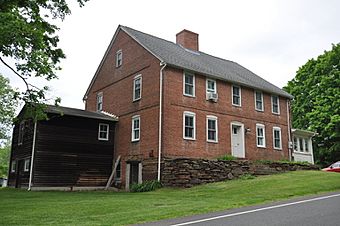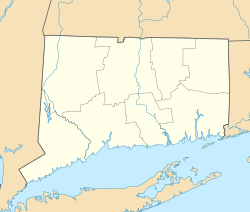Lewis-Zukowski House facts for kids
Quick facts for kids |
|
|
Lewis-Zukowski House
|
|
 |
|
| Location | 1095 S. Grand St., Suffield, Connecticut |
|---|---|
| Area | 3.3 acres (1.3 ha) |
| Built | 1781 |
| Architectural style | Colonial, Italianate, Vernacular Colonial |
| NRHP reference No. | 90000147 |
| Added to NRHP | February 21, 1990 |
The Lewis-Zukowski House is a really old and special home located in Suffield, Connecticut. It was built way back in 1781. What makes it unique is that it's one of the few houses from the 1700s in Suffield made of brick. It also has an old barn from the mid-1800s. This house is so important that it was added to the National Register of Historic Places in 1990.
Contents
What Makes This House Special?
The Lewis-Zukowski House is in a quiet, countryside area of southwestern Suffield. It sits on the west side of South Grand Street. The house is a two-and-a-half story building made of brick. It has a pointed roof and a strong stone base.
Looking at the House
On the right side of the house, there's a porch made of wood. A newer wooden part extends from the back. The front of the house has five sections with windows. The main door is in the middle, set back a bit, and has a small window above it.
The Old Barns and Buildings
North of the house, you'll find a large barn made of wood. It has vertical wooden boards on its sides and a pointed roof. This barn has a square tower on top and a round window. These features make it look a bit like the Italianate style, suggesting it was built around the 1860s.
Further back on the property, there's a tobacco barn from the early 1900s. There's also an old garage, a milk shed, and a tall silo. These buildings show how the property was used for farming long ago.
Who Lived Here?
The house was built in 1781 by a local farmer named Hezekiah Lewis. At that time, it was quite unusual to build a house out of brick in Connecticut. This makes the Lewis-Zukowski House one of the oldest brick homes in the state.
From Farmer to Mill Owner
Hezekiah Lewis wasn't very rich when he built the house. But by the time he passed away in 1805, he owned a "fulling mill." A fulling mill was a place where wool cloth was cleaned and thickened. This shows how he became more successful over time.
A New Family and Farming
In 1905, Michael Zukowski bought the property. He was an immigrant from Eastern Europe. Many immigrants like him came to the area around that time. They helped bring new life and energy to farming in the community. The Zukowski family continued the farming tradition at this historic site.



